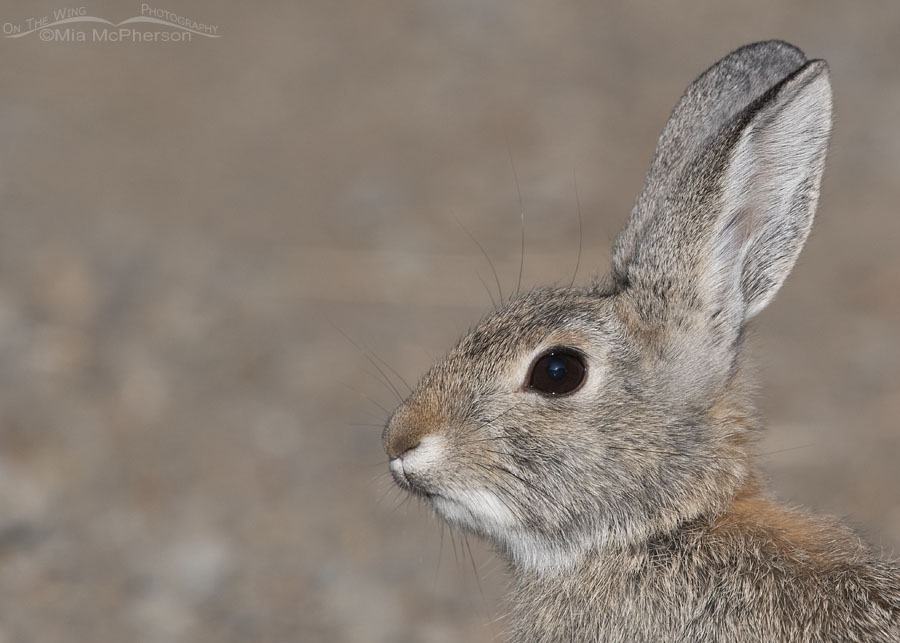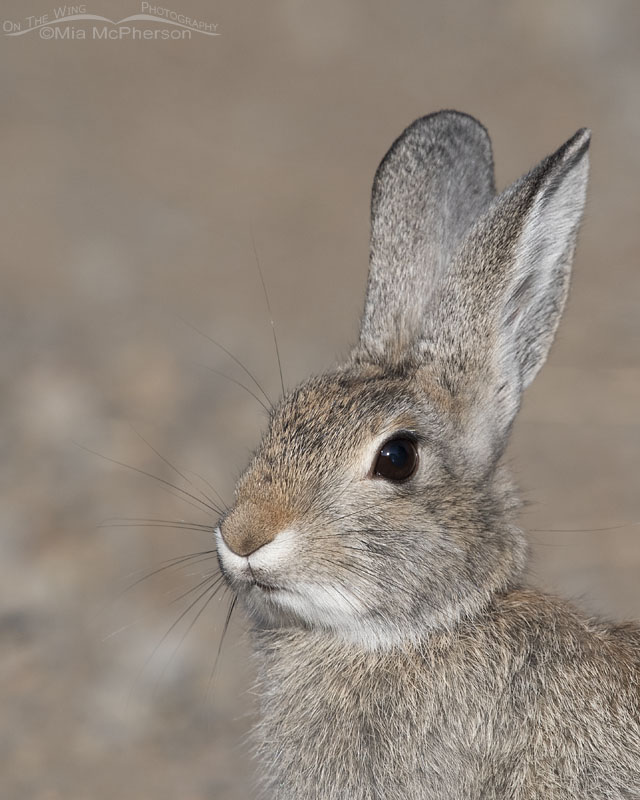 Desert Cottontail portrait – Nikon D500, f7.1, 1/2000, ISO 500, Nikkor 500mm VR with 1.4x TC, natural light
Desert Cottontail portrait – Nikon D500, f7.1, 1/2000, ISO 500, Nikkor 500mm VR with 1.4x TC, natural light
Birds are always my primary focus when I am out in the field yet I can’t resist photographing other subjects that I find in while I am out in the field. I’ve been a student of nature for as long as I can remember and starting out my life as a farmer’s daughter probably had a great deal to do with that as well as having a mother who encouraged her daughter to wander into the natural world.
I’ve been asked “How do you know so much?” on more than one occasion and the answer is that I’ve been studying the natural world a long time, I have excellent memory skills and an insatiable curiosity about the other life that I share this planet with. I also pay attention to what I can see and hear in the field almost all of the time.
Last month when I spotted a Desert Cottontail in the mountains of the West Desert I knew I wanted to take photos of the rabbit especially since it was so close that I could take portraits of it.
Some of the first photo I took of the Desert Cottontail were unusable though because there was a bright yellow piece of plastic on the right side of the back of the cottontail’s ears. I’d either have to clone that piece of trash out of my photos or delete them because the out focus yellow blob was so close to the cottontail’s ears in my files that it was terribly distracting.
The photo above is the last image of the first series of images that I took of the Desert Cottontail and the rabbit had moved its head forward just enough that I was able to crop that yellow blob out.
Tip: Paying attention to what is in the background matters. Paying attention to what is in the foreground matters too.
 Desert Cottontail close up in the West Desert – Nikon D500, f7.1, 1/2000, ISO 500, Nikkor 500mm VR with 1.4x TC, natural light
Desert Cottontail close up in the West Desert – Nikon D500, f7.1, 1/2000, ISO 500, Nikkor 500mm VR with 1.4x TC, natural light
After moving forward just a foot or two the ugly, yellow plastic blob wasn’t an issue but the Desert Cottontail wasn’t as relaxed and turned its head towards the “mobile blind” which meant I didn’t get any profile portraits from the second series of photos that I took of the rabbit.
Of the images I took in the second series the first twenty or so had the best eye contact. The rest of the photos showed the cottontail looking almost directly at me and those images didn’t appeal to me at all because they didn’t show light in the rabbit’s eyes.
Whether I am photographing birds or something else in the field I always want to take the best photos that I possibly can. These two photos of the Desert Cottontail I will keep. Sadly the rest are going into my delete bin.
Life is good.
Mia
Desert Cottontail facts and information:
Sylvilagus audubonii
- Desert Cottontails are light colored rabbits of the western U.S. whose fur has shades of tan to gray with a yellowish undertone.
- They are found in arid lands of the American Southwest and Plains states. Their range extends from eastern Montana south into the western tip of Texas and into Mexico and the western part of their range into Nevada, southern California and the Baja.
- Their habitat includes dry deserts, dry grasslands and shrublands, sagebrush steppe, pinyon-juniper forests and riparian areas.
- Desert Cottontails rarely need to drink, instead they get water mostly from the plants they eat or from dew.
- Desert Cottontails can breed at eighty days old and will breed about 8 months of year. A normal litter is about two to six young. The young leave the nest at three weeks of age.
- Ninety percent of a Desert Cottontails diet is grass but they will eat plants, forbs, cacti and shrubs. They will also eat the bark from tree branches that are close to the ground.
- Desert Cottontails live to about two years old.


so beautiful, thank you
Such a sweet bun-bun! Thank you!!!
What wonderful studies! Beautiful shots of the eyes. Thanks Mia.
What a charmer.
And yes, paying attention matters – and pays generous dividends too.
Wonderful!!, Love the variety of Nature’s offerings and your images of them…thank you…stay safe👍❤️🤞
They are so cut, I love their milk mustache.
Really cute little guys !! Images are tack sharp !! Tough to get that close to our Eastern Cottontails here in Rhode Island.
Love the shots!!
Awesome encounter. Mia
Such fine detail! Can really see the mix of colors in the fur on head, body and ears. Lovely image! Would love to see similar of jack rabbits! Thank you for the interp.
Love these photos. My goodness, they have short lives.